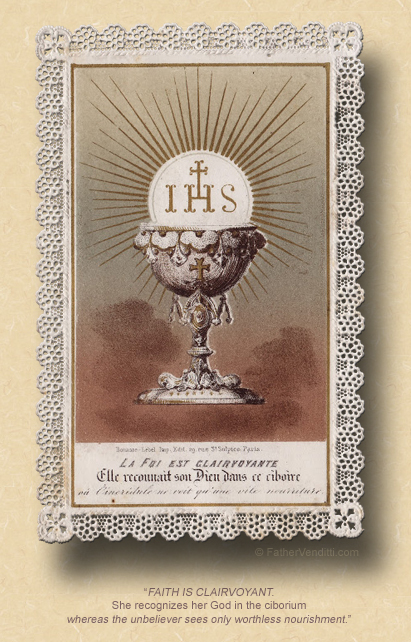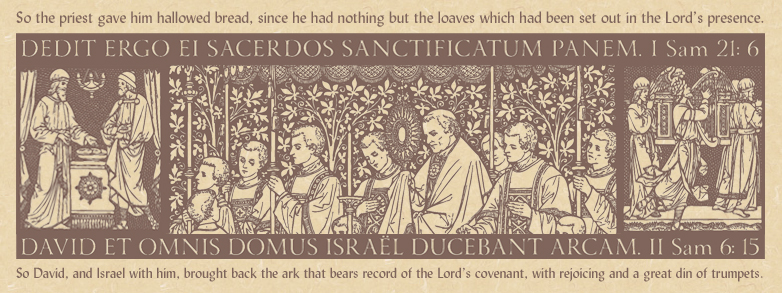Seeing with the Eyes of Faith.
The Seventeenth Friday of Ordinary Time; or, the Memorial of Saint Eusebius of Vercelli, Bishop; or, the Memorial of Saint Peter Julian Eymard, Priest.*
Lessons from the primary feria, according to the ordinary form of the Roman Rite:
• Leviticus 23: 1, 4-11, 15-16, 27, 34-37.
• Psalm 81: 3-6, 10-11.
• Matthew 13: 54-58.
|
If a Mass for Saint Eusebius is taken, lessons from the feria as above, or from the proper:
• I John 5: 1-5.
• Psalm 89: 2-5, 21-22, 25, 27.
• Matthew 5: 1-12.
…or, any lessons from the common of Pastors for a Bishop.
|
|
If a Mass for Saint Eymard is taken, lessons from the feria as above, or from the proper:
• Acts 4: 22-35.
• Psalm 34: 2-11.
• John 15:-8.
…or, any lessons from the common of Holy Men and Women for Religious; or, the common of Pastors for One Pastor.
|
The Third Class Feast of Saint Alphonsus Mary de Liguori, Bishop, Confessor & Doctor of the Church; and, the Commemoration of Saint Stephen I, Pope & Martyr.**
Lessons from the proper, according to the extraordinary form of the Roman Rite:
• II Timothy 2: 1-7.
• Psalm 118: 52-53.
• Luke 10: 1-9.
|
If a Mass for the commemoration is taken, lessons from the common "Si díligis me…" for One or Several Holy Popes:
• I Peter 5: 1-4, 10-11.
• Psalm 106: 32, 31.
• Matthew 16: 13-19.
|
FatherVenditti.com
|
 5:32 PM 8/2/2019 — Saint Luke’s account of Our Lord’s visit home to preach in His home town synagogue in Galilee includes many more details than Saint Matthew’s which we read today: what led up to that visit home, and how significant it was. He gives us details such as the Scripture passage that was read, and the content of Our Lord’s sermon there. 5:32 PM 8/2/2019 — Saint Luke’s account of Our Lord’s visit home to preach in His home town synagogue in Galilee includes many more details than Saint Matthew’s which we read today: what led up to that visit home, and how significant it was. He gives us details such as the Scripture passage that was read, and the content of Our Lord’s sermon there.
Saint Matthew’s brief account, which we read today, doesn’t included any of that, but focuses our attention only on the doubts expressed by those who heard Our Lord preach there. It’s paired with God’s instructions to Moses in Leviticus about the feasts and festivals that Jewish people are to observe, so the liturgy is very much part of the theme of today’s Scripture lessons.
Our Lord’s congregation in Galilee marveled at the unassuming wisdom of His preaching because of the simplicity of His origins. They knew Him, and didn’t know Him to be anything special. By happy coincidence, we are able today to observe the memorial of Saint Peter Julian Eymard. He was the founder of the Priest-Adorers of the Holy Eucharist and the Priests of the Blessed Sacrament. In my assignment as rector of the Blue Army Shrine, I had a first class relic of Saint Eymard displayed in the chapel there. Born in 1811, he founded the Congregation of the Blessed Sacrament, today numbering some 875 members. In 1858 he founded the Servants of Blessed Sacrament, a contemplative community of nuns; and, is the founding father of what we know today as the Eucharistic Congress.
In more ways than one, our Lord’s visit to his home town synagogue is analogous to His Eucharistic presence: just as they looked at Him and saw nothing unique about Him, so we look upon the Blessed Eucharist and see nothing that looks different from ordinary bread; it’s only with the eyes of faith that we see our Blessed Lord.
Let us pray to Saint Eymard today that we may deepen our love for our Lord in the Blessed Sacrament, and never pass up the chance to spend some time in quiet prayer with our Blessed Lord.

* A courageous defender of the Faith against the Arian Heresy, Eusebius was tortured and exiled. He is regarded as the first bishop in the West to unite the clerical and monastic vocations, dying in 371.
Born in La Mure, France, Eymard (1811-1868) became a priest in 1835 and joined the Marists in 1840. He fostered Eucharistic Adoration and founded the Priest-Adorers of the Holy Eucharist and the Priests of the Blessed Sacrament, today numbering about 900 members. In 1858 he founded the Servants of the Blessed Sacrament, a contemplative order of women. He was instrumental in establishing the custom of the International Eucharistic Congress.
** Born a Neapolitan nobleman, Liguori renounced all earthly things and established the Congregation of the Most Holy Redeemer to preach the Gospel to the poor. Known for his preaching and writing, he reluctantly accepted the bishopric of Saint Agatha in sounthern Italy, but returned to his congregation and died in 1787. In the ordinary form, his memorial was observed yesterday.
Pope Saint Stephen I was beheaded just as he was finishing Holy Mass, seated on his Episcopal chair in the catacombs in 257.
|

